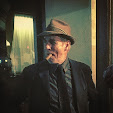First, some etymology:
Canny is from the Anglo-Saxon root ken: “knowledge, understanding, or cognizance; mental perception: an idea beyond one's ken. Thus the uncanny is something outside one's familiar knowledge or perceptions.
Sigmund Freud was fascinated by it.
He tried to understand that uneasiness, that frisson of revulsion one senses the closer one gets to the almost in Almost Human.
He called it The Uncanny.
He said this feeling is what “unconsciously reminds us of our own Id, our forbidden and thus repressed impulses perceived as a threatening force by our super-ego.”
More recently Masahiro Mori, roboticist and author of The Buddha in the Robot (Charles E. Tuttle Co.; ISBN 4333010020.) did a study that produced this
handy graph below, illustrating the sudden chasm of revulsion you find the closer you get (but not quite) to human replication.
Putting The Art in Artificial
I believe the roots of coulrophobia (fear of clowns) resides somewhere on the pratfall inducing slippery slope of The Uncanny Valley.
The clown is a kind of simulacrum of an actual human being. The make up, the wig, the sheer deranged unpredictability of the clown has an artificial sheen to it. A glint of malevolence seems to lurk behind those red noses. According to Freud people are afraid of the anarchic presence of clowns because they are afraid they will become one themselves. Just jump into their little car and join the circus. (Sounds familiar.)
Coulrophobia is a genuine fear just like acrophobia but instead of fear of heights, it is a fear born of being perched on the precipice of the yawning chasm of the Uncanny Valley.
Compensating for this natural human reaction is a kind of tight rope act for us clowns.*
*I am in no way comparing what we clowns do to the real high wire act in Kooza, where the fifth generation Quiros circus family nightly taunt gravity armed only with a combination of balance, poles, swords, bicycles and pure nerve.
Taking The Robot Out of Repitition.
I’m not sure where clowns fall on this graph but I imagine them bivouac’d somewhere on the perilous slopes of Mori’s Uncanny Valley where we run the danger of alienating 2500 people nightly.
Repetition can make a robot out of anyone.
Re-attaching to the human, child-like innocent nature of the clown is like picking a scab you can never allow to heal.
Of course repetition has its up side as well. It helps you find the economy of movement, the precision, the sheer physical geometry that allows you to do, say, a particular pratfall 10 shows a week for months at a time.**
**The adaptability of certain falls comes in handy on long runs.
You have a great shoulder roll. When the right shoulder gets bruised, can you adapt the same fall to the left shoulder?
(I trade off nightly which butt cheek I land on in one of my falls in Kooza.)
The Zen of Falling Down
There is a delicate duality at work here.
You’re a clown and the audience knows you may fall down in the course of your high jinks.
They kind of expect it.
But the clown cannot expect it.
That will kill the laugh.
Guaranteed.
The banana peel slip is only funny when the fallee’s mind is elsewhere.
When the oblivious meets the obvious and KE-BLAM!
(This seems to resonate with the idea that the clown lives perpetually in the present with little or no concern for the future.)
Meanwhile the clown, under all the brightly colored finery and his mask of make up must perfect (and maintain) the fall with mindful accuracy to avoid serious injury.
This is all under the penetrating perusal of a ravenously observant audience of 2500 or so that give you the instant feedback on the effectiveness of the bit.
And if they see you giving any indication that you know the fall is coming they will not laugh at it.
The best falls are surprises to everyone.
Especially the one doing the falling.
The clown then must be as surprised as everyone else in the room.
Maybe more so.
Tricky Landscape
Your basic pratfall is kind of like doing a three fold trick:
A trick that you didn’t know you were going to do while you trick yourself into not knowing what’s next while you perform the trick of making something look painful without hurting yourself.
Staying Human under the artificial layers, protecting the delicate latticework of tendons and bone and muscle and leaving your mind behind are just some of the handholds we cling to on the precarious slopes of The Uncanny Valley.
KE-BLAM! 10 shows a week.
"My turn!"




No comments:
Post a Comment